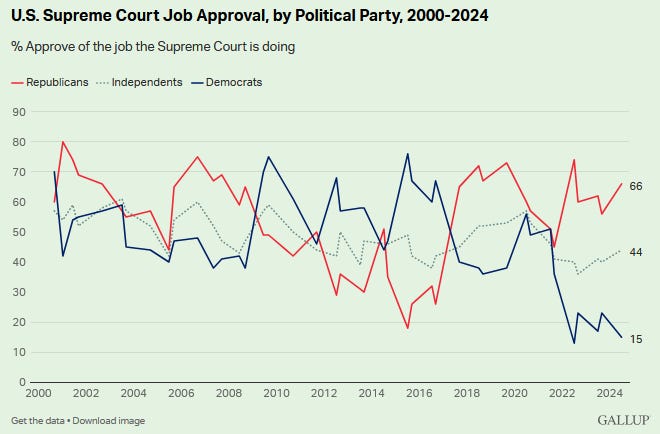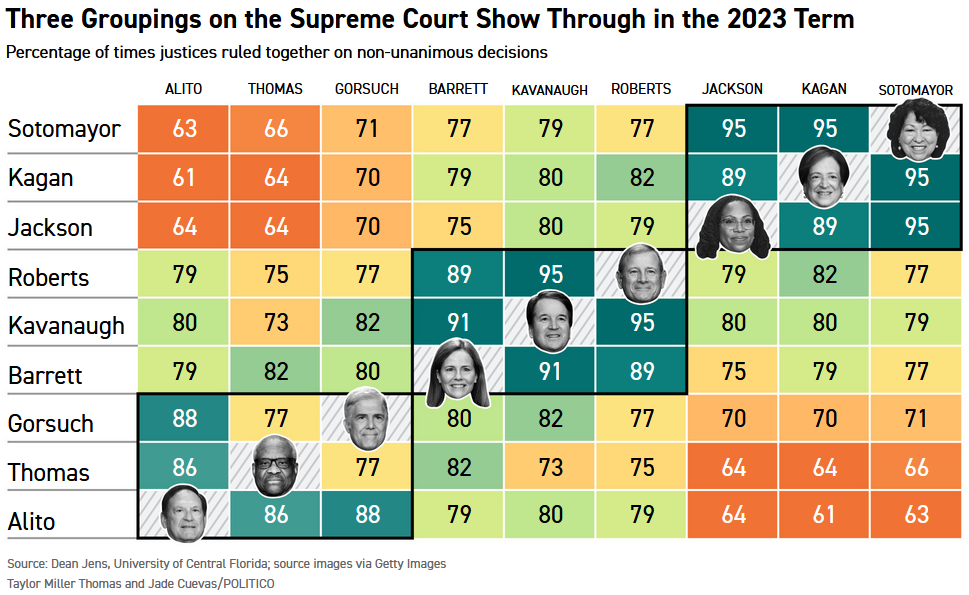Six-Chart Sunday (#35) – Of Supreme Concern
6 Infographics from the week + 1 Video (Hal Brands & Noah Smith on the New Cold War)
It’s hard to imagine the 2024 election ending without at least one major Supreme Court decision prior to Inauguration Day. From candidate ballot access to ballot integrity measures; from election day disputes to challenges to slates of electors, 2024 may be the most-litigated election in U.S. history. And in the end, all roads lead to the Supreme Court, the ultimate referee in a nation of laws.
A Very Crowded Democracy Docket. The 2024 election may be the most heavily-litigated in American history. Here’s just some of the cases our courts have already seen or may face over the next 120 days. (Referend-Him: The Not It Election).
Supreme Court Job Approval Heavily Reflects Partisans’ Perspectives on Recent Decisions. Republican support for SCOTUS spiked to 74% the month after the Dobbs decision, tied for the second highest since the 80% following Bush v Gore. Democratic support for SCOTUS peaked at 76% in 2015 after the court spared the Affordable Care Act and ruled that the Constitution guarantees a right to same-sex marriage. (Gallup)
Today’s Justices Are Very Liberal & Very Conservative by Historical Standards. Today’s liberals are among the most liberal justices in a century, just as today’s conservatives are among the most conservative. (NYT)
Are Courts Less Biased than Blues Believe?: Even though Trump appointed 28% of active federal judges as of 1/21/21, he lost 95% (61 of 64) of the cases he or allies brought challenging results or procedures from the 2020 elections, while the Trump Administration lost 58% of the cases it argued before the Supreme Court while in office… “the lowest success rate in the modern era.” (NYT)
Fewer Decisions Are Purely Partisan: “Only five of 57 cases [in the 2022-2023 term] — just 8% — were decided 6-3 with the six Republican appointees all on one side and the three Democratic appointees on the other…. About 50% of the court’s cases were decided unanimously that term…. Justices Jackson, Sotomayor, and Kagan were all more likely to be in the majority than either Samuel Alito or Clarence Thomas.” In the 2023-24 term, the number of purely partisan 6-3 decisions increased to 11 / 60, or 18%, vs 26 / 60 (43%) decided unanimously. (Politico Magazine)
Historically-High Rate of Concurring Opinions. “Even when the justices agreed, they very often could not find consensus on the rationale. Indeed, they issued concurring opinions at a record rate, the highest since at least 1937 and probably ever. Some of those opinions revealed fractures on the right, particularly on the role history should play in constitutional interpretation.” (NYT)
VIDEO
Geopolitical strategist / author Hal Brands & Everything Guru / Substack Super-blogger Noah Smith are among the leading strategists assessing the New Cold War between the U.S. & China… what it means for business, America & the world.










Great review. I am concerned that freedom of speech and information would be curtailed in the future. Permit me to share this snippet. https://quannguyen128.substack.com/p/battle-of-maling
These charts are helpful in calming attitudes toward the Courts. But the chart that disturbed me most was the first one. We cannot have a third party (unless self-funded by a billionaire) because independent candidates face enormous legal barriers to getting on the ballot. And by the time they are done facing lawsuits, often paid for by tax dollars, they have no money left actually to campaign. This is not democratic. We can argue over whether our traditional two-party system would benefit from a third centrist party, but not until we fix the fact that our system is rigged against them.